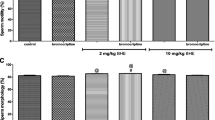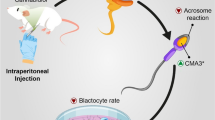Abstract
β-Caryophyllene (β-Car) is a natural antioxidant. It is Cannabis-derived cannabinoid receptors type 2 (CB2R) agonist. CBR2 are expressed in germ cells within the testes. The aim of this study was to investigate the effect of β-Car on the male rat body weight, sex organ weight, sperm count, motility and morphology, and on the histology and the ultrastructure of the testes and the cauda epididymides. Moreover, we compared these effects with the results of the reversible infertility inducer: metronidazole (MTZ). Sexually mature male rats were divided into five groups that received intraperitoneal injections of 10 mg/kg β-Car, 40 mg/kg MTZ, distilled water, tween 80 in normal saline solution (10 % v/v), or did not receive any treatment for an experimental period of 30 days. Cauda epididymal sperm suspensions were used to assess the sperm count, motility, and morphology. Histological and ultrastructural studies were performed on testes and cauda epididymides. Treatment with β-Car (10 mg/kg, i.p.) significantly increased the final body weight, but did not affect the sex organ weight. It resulted in a significant decrease in cauda epididymal sperm count, percentages of motile sperms, and sperms with normal morphology. Nevertheless, it neither affected the histology nor the ultrastructure of the testes or the cauda epididymides of the treated rats. As a CB2R, β-Car could be a promising natural male contraceptive, because 30-day treatment with 10 mg/kg β-Car did not affect spermatogenesis but negatively affected spermiogenesis.










Similar content being viewed by others
References
Abbas MA, Taha MO, Zihlif MA, Disi AM (2013) Beta-caryophyllene causes regression of endometrial implants in a rat model of endometriosis without affecting fertility. Eur J Pharmacol 702:12–19
Agirregoitia E, Carracedo A, Subiran N, Valdivia A, Agirregoitia N, Peralta L, Velasco G, Irazusta J (2010) The cb(2) cannabinoid receptor regulates human sperm cell motility. Fertil Steril 93:1378–1387
Amiel E, Ofir R, Dudai N, Soloway E, Rabinsky T, Rachmilevitch S (2012) Beta-caryophyllene, a compound isolated from the biblical balm of gilead (Commiphora gileadensis), is a selective apoptosis inducer for tumor cell lines. Evid Based Complement Alternat Med 2012:1–8
Baltus AE, Menke DB, Hu YC, Goodheart ML, Carpenter AE, de Rooij DG, Page DC (2006) In germ cells of mouse embryonic ovaries, the decision to enter meiosis precedes premeiotic DNA replication. Nat Genet 38:1430–1434
Calleja MA, Vieites JM, Montero-Melendez T, Torres MI, Faus MJ, Gil A, Suarez A (2013) The antioxidant effect of beta-caryophyllene protects rat liver from carbon tetrachloride-induced fibrosis by inhibiting hepatic stellate cell activation. Br J Nutr 109:394–401
Chang HJ, Kim JM, Lee JC, Kim WK, Chun HS (2013) Protective effect of beta-caryophyllene, a natural bicyclic sesquiterpene, against cerebral ischemic injury. J Med Food 16:471–480
Creasy DM (2003) Evaluation of testicular toxicology: a synopsis and discussion of the recommendations proposed by the society of toxicologic pathology. Birth Defects Res B Dev Reprod Toxicol 68:408–415
Di Sotto A, Maffei F, Hrelia P, Castelli F, Sarpietro MG, Mazzanti G (2013) Genotoxicity assessment of beta-caryophyllene oxide. Regul Toxicol Pharmacol 66:264–268
El-Nahas AF, El-Ashmawy IM (2004) Reproductive and cytogenetic toxicity of metronidazole in male mice. Basic Clin Pharmacol Toxicol 94:226–231
Galdino PM, Nascimento MV, Florentino IF, Lino RC, Fajemiroye JO, Chaibub BA, de Paula JR, de Lima TC, Costa EA (2012) The anxiolytic-like effect of an essential oil derived from spiranthera odoratissima a. St. Hil. Leaves and its major component, beta-caryophyllene, in male mice. Prog Neuropsychopharmacol Biol Psychiatry 38:276–284
Gertsch J, Leonti M, Raduner S, Racz I, Chen JZ, **e XQ, Altmann KH, Karsak M, Zimmer A (2008) Beta-caryophyllene is a dietary cannabinoid. Proc Natl Acad Sci USA 105:9099–9104
Grimaldi P, Orlando P, Di Siena S, Lolicato F, Petrosino S, Bisogno T, Geremia R, De Petrocellis L, Di Marzo V (2009) The endocannabinoid system and pivotal role of the CB2 receptor in mouse spermatogenesis. Proc Natl Acad Sci USA 106:11131–11136
Horvath B, Mukhopadhyay P, Kechrid M, Patel V, Tanchian G, Wink DA, Gertsch J, Pacher P (2012) Beta-caryophyllene ameliorates cisplatin-induced nephrotoxicity in a cannabinoid 2 receptor-dependent manner. Free Radic Biol Med 52:1325–1333
Legault J, Pichette A (2007) Potentiating effect of beta-caryophyllene on anticancer activity of alpha-humulene, isocaryophyllene and paclitaxel. J Pharm Pharmacol 59:1643–1647
Lucio RA, Tlachi-Lopez JL, Eguibar JR, Agmo A (2013) Sperm count and sperm motility decrease in old rats. Physiol Behav 110–111:73–79
Maccarrone M (2013) Endocannabinoids as markers of sperm quality: hot spots. Front Endocrinol (Lausanne) 4:169
McClain RM, Downing JC, Edgcomb JE (1989) Effect of metronidazole on fertility and testicular function in male rats. Fundam Appl Toxicol 12:386–396
Molina-Jasso D, Alvarez-Gonzalez I, Madrigal-Bujaidar E (2009) Clastogenicity of beta-caryophyllene in mouse. Biol Pharm Bull 32:520–522
Mudry MD, Palermo AM, Merani MS, Carballo MA (2007) Metronidazole-induced alterations in murine spermatozoa morphology. Reprod Toxicol 23:246–252
Narayana K, Prashanthi N, Nayanatara A, Kumar HH, Abhilash K, Bairy KL (2005) Effects of methyl parathion (O,O-dimethyl O-4-nitrophenyl phosphorothioate) on rat sperm morphology and sperm count, but not fertility, are associated with decreased ascorbic acid level in the testis. Mutat Res 588:28–34
Narayana K, Verghese S, Jacob SS (2009) l-ascorbic acid partially protects two cycles of cisplatin chemotherapy-induced testis damage and oligo-astheno-teratospermia in a mouse model. Exp Toxicol Pathol 61:553–563
Page ST, Amory JK, Bremner WJ (2008) Advances in male contraception. Endocr Rev 29:465–493
Rapino C, Battista N, Bari M, Maccarrone M (2014) Endocannabinoids as biomarkers of human reproduction. Hum Reprod Update 20:501–516
Rossi P, Lolicato F, Grimaldi P, Dolci S, Di Sauro A, Filipponi D, Geremia R (2008) Transcriptome analysis of differentiating spermatogonia stimulated with kit ligand. Gene Expr Patterns 8:58–70
Schuel H, Goldstein E, Mechoulam R, Zimmerman AM, Zimmerman S (1994) Anandamide (arachidonylethanolamide), a brain cannabinoid receptor agonist, reduces sperm fertilizing capacity in sea urchins by inhibiting the acrosome reaction. Proc Natl Acad Sci USA 91:7678–7682
Seed J, Chapin RE, Clegg ED, Dostal LA, Foote RH, Hurtt ME, Klinefelter GR, Makris SL, Perreault SD, Schrader S, Seyler D, Sprando R, Treinen KA, Veeramachaneni DN, Wise LD (1996) Methods for assessing sperm motility, morphology, and counts in the rat, rabbit, and dog: a consensus report. Ilsi risk science institute expert working group on sperm evaluation. Reprod Toxicol 10:237–244
Tahtamouni LH, Alqurna NM, Al-Hudhud MY, Al-Hajj HA (2011) Dandelion (taraxacum officinale) decreases male rat fertility in vivo. J Ethnopharmacol 135:102–109
Whan LB, West MC, McClure N, Lewis SE (2006) Effects of delta-9-tetrahydrocannabinol, the primary psychoactive cannabinoid in marijuana, on human sperm function in vitro. Fertil Steril 85:653–660
Acknowledgments
The authors thank the deanship of scientific research at the University of Jordan and the scientific research support fund/Jordanian Ministry of Higher education for funding this work. Appreciation is also to Isra University, Amman, Jordan, because the laboratory animals’ part of this research was conducted in Isra University animal house and laboratories. The authors thank Dr. Rasha Abu Eid for review of the manuscript and valuable suggestions.
Author information
Authors and Affiliations
Corresponding author
Ethics declarations
Conflict of interest
The authors have no conflicts of interest to declare.
Rights and permissions
About this article
Cite this article
Al-Alami, Z.M., Shraideh, Z.A. & Taha, M.O. β-Caryophyllene as putative male contraceptive: enhances spermatogenesis but not spermiogenesis in albino rats. Med Chem Res 24, 3876–3884 (2015). https://doi.org/10.1007/s00044-015-1428-3
Received:
Accepted:
Published:
Issue Date:
DOI: https://doi.org/10.1007/s00044-015-1428-3




